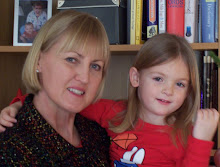After the weight of the ice age glaciers receded,
Gotland has raised up from the sea. The limestone that makes up the island has eroded at different rates. Coral reef limestone was the hardest, so remnants of those Baltic reefs remain as
rauks, cliffs and caves. This
rauk was near
Lickershamn, north of
Visby.
 Ingvor
Ingvor noted that it has the typical Swedish potato nose. After that we could see profiles in many of the
rauks.

This is Chuck in front of
Jungfru rauk at
Lickershamn. It is about 12 meters high, and 20 meters above Baltic sea level. Translated from the website link: The "Maiden"
rauk has gotten its name after the tragic story about the Maiden
Öllegard and her beloved Helge, which ended with them throwing themselves into the sea. (Which reminds me of a pun: She threatened to jump off the cliff, but it was only a bluff.)

In June, Andrea,
Haylie and I toured
Lummelunda cave. This is the photo of the original cave opening, which only skinny kids could crawl into. Since then, they have built an opening for tourists (and grandmothers), and an interpretive center. They showed
this video before we went into the cave, about the three boys who discovered it.

We took a nice hike at
Högklint, just south of
Visby, where
Haylie and I explored a shallow cave.
 We've had just the right amount of rain this summer, something never said about Minnesota. It rains every few days, then nice days of sun. My plants are doing well. I should also give credit to my neighbor Betty, who watered for me when I was gone this summer.
We've had just the right amount of rain this summer, something never said about Minnesota. It rains every few days, then nice days of sun. My plants are doing well. I should also give credit to my neighbor Betty, who watered for me when I was gone this summer.





 In June, Andrea,
In June, Andrea, 


 The quarry at Sundre.
The quarry at Sundre. The blocks of limestone are sawed into slices with diamond tipped sawblades, lots of water, and very slow progress. Some of the limestone after slicing, but before polishing or cutting to size.
The blocks of limestone are sawed into slices with diamond tipped sawblades, lots of water, and very slow progress. Some of the limestone after slicing, but before polishing or cutting to size.


 The website for Vamlingbo Prästgården (parish farm) is found here:
The website for Vamlingbo Prästgården (parish farm) is found here:



